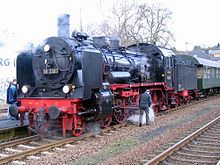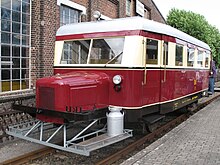Bochum Railway Museum
 Bochum-Dahlhausen Railway Museum |
|
| Data | |
|---|---|
| place | Bochum-Dahlhausen |
| Art |
Railway Museum
|
| opening | 1977 |
| operator |
Bochum Railway Museum Foundation
|
| Website | |
| ISIL | DE-MUS-023310 |

The Bochum Railway Museum is a railway museum in the southwest of Bochum , which was opened in 1977 on the site of the railway depot in Dahlhausen, which was built from 1916 to 1918 and closed in 1969, by the Deutsche Gesellschaft für Eisenbahngeschichte e. V. was founded and has been operated by the Bochum Railway Museum Foundation since 2011 . With an area of around 46,000 m², it is the largest private railway museum in Germany.
The center of the museum is the 14-room locomotive shed with a 20-meter turntable , water tower , workshops and locomotive treatment systems such as a coaling plant , water crane and sand tower. There are also two additional exhibition halls with tracks on the site. An operational 600 mm field track is also available. The entire facility of the former depot is a listed building.
The museum is an anchor point on the Route of Industrial Culture .
history
The Bochum Railway Museum has developed from a depot to currently the largest private railway museum in Germany. The plant was built in the years 1916–1918. The locomotives of the numerous neighboring depots were examined and repaired here until 1925. From 1925 the Dahlhausen / Ruhr depot received its own locomotives and drivers from the Hattingen / Ruhr and (Essen) -Steele-Nord depots.
The main service for the steam locomotives used here was the heavy freight train route service, with coal transport playing the predominant role for the hard coal mining in the Ruhr area . The freight trains assembled in the freight yard had to be driven to their destination stations, with empty freight wagons being brought to the mines in return.
The average number of locomotives was 50 steam locomotives. 522 people were employed in the depot in 1957, which also included a repair hall for defective goods wagons or goods wagons requiring inspection. In Wattenscheid - Eppendorf there was also such a freight car repair, which was subordinate to the Bochum-Dahlhausen railway depot. During the Second World War , the Dahlhausen / Ruhr depot had to deliver many steam locomotives to the Eastern Front. So-called rental locomotives from France and Belgium were then used as replacements .
The destruction of the Möhnetalsperre dam caused great damage to the railway systems in the Ruhr valley due to the tidal wave of the Ruhr . During the retreat of the German army were railway bridge Hattingen , the railway bridge Dahlhausen that RhE Bridge Steele (near the Holteyer port , not rebuilt) and the Ruhrbrücke Steele blasted. This resulted in considerable restrictions in railway operations. In addition, the Dahlhausen depot was destroyed by numerous bomb hits.
After the end of the war there was a severe shortage of coal and despite the poorly repaired vehicles and railway systems, enormous transport services were required of the railway workers for the emerging economic miracle .
In the mid-1960s, the Bochum-Dahlhausen freight yard was still able to handle more than 2000 freight wagons a day.
At the end of the 1960s, coal mining in the Ruhr area had become unprofitable and the mines were closed. This meant that the main use of the locomotives at the Bochum-Dahlhausen railway depot was no longer required. The depot was closed on August 1, 1969 as an independent service and some of the facilities were dismantled. The freight car repair was given up in 1982.
The German Society for railway history offset the operating plant site from 1968 gradually returns to the original condition of the steam era and made it in 1977 to the public as a museum accessible. Since then, the aim of the Railway Museum has not only been to preserve and restore vehicles, but also to create a typical railway environment with appropriate buildings and technical systems. The former Bochum-Dahlhausen depot, completely leased by the Deutsche Bundesbahn , offers the best conditions for this.
In 1985, as part of the event 150 Years of the German Railways, a large vehicle show took place at the neighboring former marshalling yard in Bochum-Dahlhausen, in which the Railway Museum was also involved. It is one of the largest of its kind.
On July 14, 2011, the German Society for Railway History and the City of Bochum founded the Railway Museum Bochum Foundation, which has owned the vehicle collection ever since. Since that date the museum has been called the Bochum Railway Museum.
Self-image and tasks
The aim of the museum, founded in 1977, is to preserve the railway of the steam locomotive era for future generations and to present its importance for the development of society and the economy in Germany. Volunteers develop events and special trips to give visitors a lively and thus more lasting impression of historically significant technology. On some days, such as the annual museum festivals in April and September, various vehicles are set in motion and can be viewed by visitors in action.
Breakpoint
On the regular day trips, passengers experience a nostalgic way of traveling. From the small stop there are museum train rides through the Ruhr Valley, which are offered with various vehicles. A Prussian P 8 (38 2267) is used as a locomotive once a month on the regularly operated route from the museum to Wengern-Ost . The Modell-Eisenbahn-Club Essen & Umgebung e. Founded in 1949 also participates in the museum railway . V. with a restored and managed passenger coach from MAN from 1921.
In addition, on Sundays a shuttle train runs from the railway museum to Bochum-Dahlhausen station , where there is a connection to the S-Bahn to Essen and Hattingen . This shuttle train consists of a Wismar rail bus , colloquially called a pig's nose.
| line | Line course | Tact | operator |
|---|---|---|---|
| RB |
Ruhr Valley : Railway Museum - Bochum-Dahlhausen - Hattingen (Ruhr) - Witten-Herbede - Wengern-Ost |
First Sat & First Sun of the month (April-October) | Bochum Railway Museum |
| RB |
Pig's nose: Railway Museum - Bochum-Dahlhausen |
Sun / celebration 30 min | Bochum Railway Museum |
Exhibition and exhibits
The origins of the vehicle collection go back to 1967. Various steam locomotives and other technically interesting railway vehicles from different epochs are on display. The vehicle collection includes more than 120 rail vehicles from the period from 1853 to 1976. These exhibits give visitors a comprehensive overview of the development of locomotives and wagons on the German railways. In addition to important and trend-setting types of locomotives, striking passenger and freight cars are also preserved for posterity. Many of the exhibits are considered to be rarities because they are extremely rare or the only surviving specimen that has been saved from scrapping. But also special areas of the railway industry such as signaling technology and ticket printers are documented using preserved historical devices. The exhibits include, among other things, a signal collection with a functioning Prussian stand signal box that was in Cologne-Mülheim until 1982. The exhibits are looked after by around 120 employees, who are mostly volunteers.
Examples of the standard gauge locomotives on display :
- DRG series 01
- DRG class 44
- DR series 50
- Prussian T 12 (DB class 74)
- DRG series 80 in the colliery livery as RAG D724
- Prussian P 8 (DB class 38)
- Prussian T 9.1 , exhibited in front of the Starlight Express Theater
- Prussian T 20 (DR series 95)
- Württemberg Hz (DB class 97.5)
- Prussian G 8.1 (DB class 55)
- DB class 66
- BLE 146 , type ELNA 2
- bay. EP 2 (E 32)
- DR series E 94
- Wehrmacht locomotive WR 360 C 14 (DB class V 36)
- DB class V 100
- Wismar rail bus
- Rail-road omnibus
- Hibernia 41-E
- DB class ETA 150
- Henschel E 1200
- Henschel DH 500 Ca , former factory locomotive No. 5 of the Opel factory in Bochum
- Tunnel measuring car DB 712 001
Filming location for cinema and television productions
Vehicles and systems of the Railway Museum have played and are involved in film and television productions several times. For example, a large part of the railroad recordings of the multi-award-winning film The Miracle of Bern (including the German Film Prize and the Locarno Prize ) were made in the old Dahlhausen train station and on the museum grounds . Other film productions, some of which were shot in the Bochum Railway Museum or in its historic vehicles, are Berlin 36 (2009), Das Blaue vom Himmel (2011) and Landauer (2013). The historical backdrop of the former depot was also used for various television productions, such as the hit lists of the West on WDR , WDR local time , Galileo magazine, the head ball show or Die Sendung mit der Maus .
See also
literature
- Harald Vogelsang: The vehicles and systems of the Bochum-Dahlhausen Railway Museum . 12th edition, DGEG, Werl 2002. ISBN 3-921700-99-X
- Harald Vogelsang: The Bochum-Dahlhausen depot and the railway in the central Ruhr valley. Eisenbahn-Kurier Verlag, Freiburg 1988. ISBN 3-88255-430-4
Web links
- Description of this attraction and anchor point as part of the Route of Industrial Heritage
- Bochum Railway Museum
- German Society for Railway History V.
- The Ruhr Valley Railway
Coordinates: 51 ° 25 ′ 55 ″ N , 7 ° 7 ′ 28 ″ E
Individual evidence
- ^ "Schweineschnäuzchen" train station commuter train ( Memento from April 15, 2015 in the Internet Archive )











